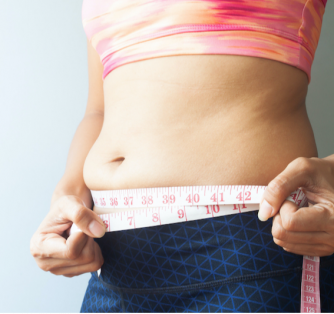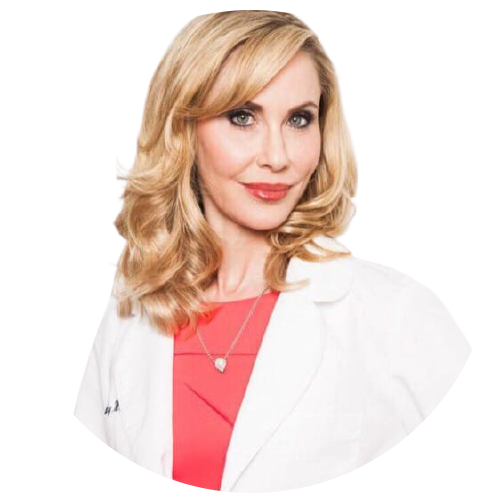Menu
Weight loss
Hormones
Sex
EXPLORE
MEET NU IMAGE MEDICAL
TREATMENTS
MEET NU IMAGE MEDICAL
TREATMENTS
MEET NU IMAGE MEDICAL
Endometriosis Belly Pooch: How to Lose Weight and Keep it Off


Most health conditions come with undesirable side effects. Maybe you gain weight. Maybe you find it hard to sleep. These are common with many conditions, but endometriosis produces an undesirable side effect—the endometriosis belly pooch.
So what exactly is the Endometriosis belly? Endometriosis belly refers to the swelling and bloating women with Endometriosis experience. With Endometriosis, tissue that is very similar to that of the uterine lining “grows outside of the uterus,” experts say. Although this tissue grows outside the uterus, it doesn’t belong there. Over 11 percent of women of childbearing age have endometriosis, so it is more common than most people know. The Endometriosis belly causes discomfort and other problems.
Pain from Endometriosis belly can be severe, and it causes a distended abdomen. Stomach bloating from this condition makes your abdomen look larger and puts pressure on your stomach and back. It also causes gas pains, nausea, and constipation and bloating. Pain from stomach swelling can go on for days and even weeks.
Most women experience some pain at different times during their menstrual cycle, which can cause bloating and mild discomfort. Unfortunately, bloating is a hallmark of Endometriosis, and consequently, many women suffer from Endometriosis belly. How do you lose the weight from Endometriosis belly and keep it off for the long-term?
If you’re looking to shed pounds and lose the Endometriosis belly, experts recommend avoiding inflammatory foods. Inflammatory foods are processed foods, such as dairy, gluten, meat, caffeine, and alcohol. Inflammatory foods enhance the inflammation that Endometriosis causes. To lose the Endometriosis belly, it is essential to make dietary changes.
To avoid these inflammatory foods, it may help to avoid eating what experts call FODMAP foods. These are foods, such as wheat, dairy, legumes, and certain fruits and vegetables. Cutting out these foods will reduce gas and bloating. Drink ginger or peppermint tea to ease pain and resolve digestive issues. You should also increase your fiber intake. This fights constipation and gets your digestive system working properly.
There are cases where you may need to see a doctor. It is especially important to get a doctor’s diagnosis if you experience frequent and painful bloating or bloating that lasts for days. Your doctor will determine the cause of your bloating by performing a transvaginal ultrasound or an ultrasound of your stomach. This allows the doctor to see if there is anything abnormal in your pelvic area, such as cysts, scar tissues, or other tissues.
To ease Endometriosis belly, doctors place a special emphasis on treating endometriosis, the problem that causes Endometriosis belly in the first place. Your doctor may recommend that you take birth control pills or supplemental hormones. These can “regulate monthly hormonal changes that cause tissues to grow outside the uterus. Other options that your doctor can explore are Gonadotropin hormones (GnRH). These can stop estrogen from being produced, “which stimulates the ovaries,” experts say.
Other treatment options for Endometriosis belly include:
-
Danazol. Danazol is a manufactured androgen that blocks certain hormones. Danazol is also known as Danocrine.
-
Laparoscopy. This minimally invasive procedure removes tissue that is growing outside of the uterus. During a laparoscopy, your doctor will insert an instrument called a laparoscope into your abdomen. Your doctor makes an incision and may take a sample of tissue. This is called a biopsy.
-
Hysterectomy. Your doctor could potentially recommend that you have your uterus removed through a procedure called a hysterectomy. However, hysterectomies are typically reserved for women with severe or unbearable pain, and who don’t want to get pregnant.
Although little research has been done on why endometriosis causes weight gain, it is undoubtedly a problem for many. The pain associated with Endometriosis belly can cause many women to eat less, which leads to weight loss, according to Medical News Today.
Some studies have found that medications for endometriosis cause weight gain. If you are on medication for endometriosis, it is a good idea to discuss other options with your doctor. As with any diet, it is important to eat healthy and exercise when you want to lose Endometriosis belly weight and maintain your weight loss.
You can also turn to weight loss programs, such as WAYT-less™, a weight loss program developed by Nu Image Medical. WAYT-less™can lead to fast and sustainable weight loss. WAYT-less™contains three different medications that are split into two daily doses. WAYT-less™regulates your blood sugar, improves digestion, and boosts energy levels. It also lowers insulin resistance. This weight loss program is physician prescribed, contains no hormones, and has no nutrient deficiencies.
With this weight loss program, you are allowed to eat a wide variety of foods, and you do not need to significantly limit your calorie intake.
What are the symptoms of Endometriosis? According to the Mayo Clinic, pelvic pain, which is a sign of menstruation, is a symptom of Endometriosis. Painful menstrual periods and painful intercourse are also both signs of Endometriosis. Women with Endometriosis have period symptoms that are much worse than what most women experience.
According to Johns Hopkins Medicine, menstrual cramps that extend far below the stomach or back are signs of Endometriosis. There is a distinct connection between Endometriosis and weight gain.
Endometriosis causes weight gain in a number of ways. Bloating doesn’t cause weight gain, rather bloating and weight gain are both symptoms of Endometriosis. However, it can make you look and feel heavier. This makes it look as though you have gained weight.
Many women with Endometriosis struggle to lose weight, because the condition makes it harder to lose weight. Diet and exercise are key to losing weight, but experts recommend that you significantly increase your physical activity. This means walking as much as you can and as often as possible. In fact, experts recommend that you do “150 to 300 minutes of moderate-intensity cardio exercise and 75 to 150 minutes of high-intensity cardio exercise” per week.
You should increase your activity as much as possible. Do strength training at least two times each week. To lose weight and lose the Endometriosis pooch, you should also eat high-fiber and filling foods. This means eating lean meats, fruits, vegetables, and whole grains. These help you manage your weight and may minimize your cravings for unhealthy and high-calorie foods.
Endometriosis can impact your appetite. Because Endometriosis can cause digestive issues, those with this condition may become constipated. This can affect your appetite, and you may not feel like eating much. You can also have surgery to reduce bloating and remove growths. This surgery has the potential to cause weight loss, although it is not guaranteed.
According to PubMed, the continuous use of oral contraception does not affect one’s chances of developing endometrial hyperplasia.
Endometriosis is an estrogen-dependent inflammatory disease, and experts assert that high estrogen levels and inflammation can worsen the symptoms of Endometriosis. Diet can affect both of these factors. Estrogen is an essential hormone that the body needs to function properly. However, estrogen levels that are too high can make the symptoms of Endometriosis worse. Too much estrogen can make menstrual cramping worse.
However, fiber and certain foods can help resolve this. Adults should consume a total of 35 milligrams of fiber per day. To do this, increase your intake of fruits and vegetables. Minimize your consumption of calorie-filled juices, and opt for whole foods instead. If you really want a sweet treat, you can add ground flaxseed to smoothies and home-baked goods.
Flaxseed is a great source of insoluble fiber which stays in your digestive tract long after you have eaten. To lose the Endo pooch and keep the weight off, you should eat beans, legumes, lentils, and chickpeas, according to the Cleveland Clinic. Additionally, you can eat more rice and whole-grain pasta.
Increase your intake of good fats. Foods that are high in Omega-3 fatty acids, like fish, reduce inflammation and include such foods as tuna, sardines, and salmon. Nuts and seeds are also great sources of Omega-3 fatty acids. Load up on nuts, such as chia seeds. In addition, monounsaturated fats are great for reducing inflammation. Women with Endometriosis may benefit from eating avocados, olive oil, peanut butter, and Safflower oil.
Certain minerals can regulate your menstrual cycle and make your muscles relax. Foods that are high in Magnesium can help soothe menstrual cramps. Such foods include dark chocolate, and leafy greens. Kale and dark lettuce are especially beneficial. You should load up on black beans, spinach, and edamame.
These foods are high in zinc, which is why they are good for regulating your menstrual cycle. Other foods that are high in zinc include pumpkin seeds, almonds, turkey, and chicken. When it comes to red meat, be sure to limit your intake. Have only two servings of low-fat red meat per
week. Oysters, lobsters, and crab are also good sources of zinc.
To lose the Endometriosis belly, avoid certain foods. Alcohol can boost inflammation in your body. Avoid this as much as possible, and limit the amount of caffeine you consume. Of course, it is still important to keep up with diet and exercise. Also, stick with a healthy diet and healthy food choices.
15 Sources
Nu Image Medical has strict sourcing guidelines to ensure our content is accurate and current. We rely on peer-reviewed studies, academic research institutions, and medical associations. We strive to use primary sources and refrain from using tertiary references.
https://www.ginsen-london.com/blog/endo-belly/
https://maidenlanemedical.com/endometriosis/endo-belly/
https://www.healthline.com/health/endo-belly
https://my.clevelandclinic.org/health/articles/10132-menstrual-cycle
https://www.healthline.com/health/endo-belly#other-bloated-belly-causes
https://www.healthline.com/health/endometriosis/laparoscopy-for-endometriosis
https://www.medicalnewstoday.com/articles/324014#the-link-with-weight-gain
https://www.mayoclinic.org/diseases-conditions/endometriosis/symptoms-causes/syc-20354656
https://www.hopkinsmedicine.org/health/conditions-and-diseases/endometriosis
https://www.newlifefertilityclinic.com/blog/connection-between-endometriosis-and-weight-gain
https://www.medicalnewstoday.com/articles/324014#fa-qs
https://pubmed.ncbi.nlm.nih.gov/23083413/
https://www.acog.org/womens-health/faqs/endometrial-hyperplasia
https://www.medicalnewstoday.com/articles/263405
https://www.health.harvard.edu/a_to_z/cysts-overview-a-to-z
This article is for informational purposes only and does not constitute medical advice. The information contained herein is not a substitute for and should never be relied upon for professional medical advice. Always talk to your physician about the risks and benefits of any treatment. Nu Image Medical may not offer the medications or services mentioned in this article.
